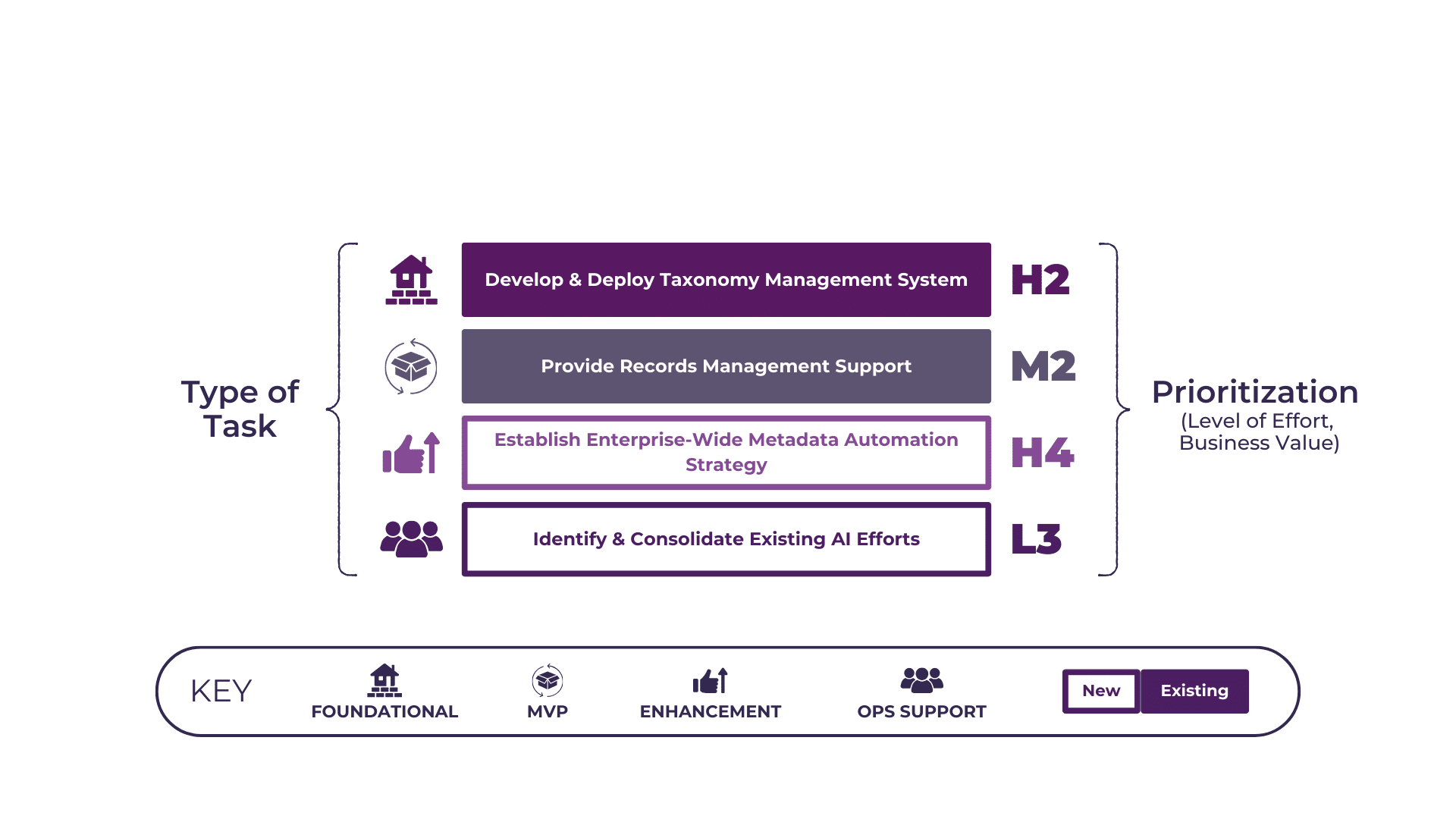
The Challenge
A global energy company sought support in detailing and aligning their information management (IM) team’s roadmaps for all four of their IM products – covering all managed applications, services, projects, and capabilities – to help them reach their target state vision of higher levels of productivity, more informed decision-making, and quality information made available to all of their users.
They were facing the following challenges:
- Recently-created products with immature, internally-focused roadmaps, resulting in missed opportunities for incorporation of industry trends and standards;
- Limited alignment across products, resulting in unnecessary duplicative work, under-standardization, and a lack of business engagement;
- Varying levels of granularity and detail across product roadmaps, resulting in some confusion around what tasks entail;
- Inconsistently defined objectives and/or business cases, resulting in unclear task goals; and
- Isolated, uncirculated efforts to harness artificial intelligence (AI), resulting in a fragmented AI strategy and time lost performing tasks manually that could have been automated.

The Solution
The energy company engaged Enterprise Knowledge (EK) over a 3.5-month time period to refine their product roadmaps and align and combine them into a unified 5-year roadmap for the entire portfolio. In addition, the company tasked EK with developing a supplemental landscape design diagram to visualize the information management team’s technical scope to strengthen the delivery per product and value to the company.
EK began by analyzing existing roadmaps and reviewing them with the product managers, identifying the target state for each. We facilitated multiple knowledge gathering sessions, conducted system demos, and analyzed relevant content items to understand the strengths, challenges, and scope of each product area, as well as the portfolio as a whole.
EK then provided recommendations for additional tasks to fill observed gaps and opportunities to consolidate overlap, aligning the roadmaps across 5 recommended KM workstreams:
- Findability & Search Insights: Provide the business with the ability to find and discover the right information at the time of need.
- Graph Modeling: Develop a graph model to power search, analytics, recommendations and more for the IM team.
- Content & Process Governance: Establish and maintain content, information, and data governance across the company to support reuse and standardization.
- Security & Access Management: Support the business in complying with regulatory requirements and security considerations to safeguard all IM information assets.
- Communications & Adoption: Establish consistent processes and methods to support communication with the business and promote the adoption of new tools/capabilities.
To strengthen and connect the organization’s AI strategy, EK threaded automation throughout and incorporated it within each workstream wherever possible and/or feasible. The goal of this was to improve business efficiency and productivity, as well as to move the team one step closer to making IM “invisible.” Each task was also assigned a type (foundational, MVP, enhancement, operational support), level of effort (low, medium, high), business value (1 (low) to 5 (high) on a Likert scale), and ownership (portfolio vs. individual products). EK marked which tasks already existed in the product roadmaps and which ones were newly recommended to supplement them. By mapping the tasks to the 5 workstreams in both a visual roadmap diagram and an accompanying spreadsheet, the IM team was able to see where tasks were dependent on each other and where overlap was occurring across the portfolio.
An abstracted view of one task from each product’s roadmap, demonstrating how the task type and prioritization factors were assigned for readability.
Additionally, as supplemental material to the roadmaps, EK developed a diagram to visualize the team’s technical landscape and provide a reference point for connections between tools and capabilities within the portfolio and the company’s environment, as well as to show dependencies between the products as mapped to EK’s industry standard framework (including layers encompassing user interaction, findability and metadata, and governance and maintenance). The diagram delineated between existing applications and platforms, planned capabilities that haven’t been put in place yet, and recommended capabilities that correspond to EK’s suggested future state tasks from the roadmaps, and clearly marked AI-powered/-assisted capabilities.

The EK Difference
Throughout the engagement, time with stakeholders was difficult to find. To make sure we were able to engage the right stakeholders, EK developed a 15-minute “roadshow” and interview structure with targeted questions to optimize the time we were able to schedule with participants all across the globe. Our client team praised this during project closeout, claiming that the novel approach enabled more individuals with influence to get in the room with EK, generating more organic awareness of and excitement for the roadmap solutions.
Another key ingredient EK brought to the table was our expertise and insight into AI solutioning, tech and market trends, and success stories from other companies in the energy industry. We injected AI and other automation into the roadmaps wherever we identified the opportunity – prioritizing a strategy that focused on secure and responsible AI solutions, data preparedness, and long-term governance – and were even able to recommend a backlog of 10 unique pilots (with varying levels of automation, depending on the targeted subject and product area) to help the company determine their next steps.

The Results
As a result of our road mapping alignment efforts with the IM team, each product manager now has more visibility into what the other products are doing and where they may overlap with, complement, or depend on their own efforts, enabling them to better plan for the future. The Unified Portfolio Roadmap, spanning 5 years, provides the energy company with a single, aligned view of all IM initiatives, accompanied by four Product Roadmaps and a Technical Landscape Diagram, and establishes a balance between internal business demand, external technologies, strategic AI, and best-in-class industry developments.
The energy company also chose to implement two of the pilots EK had recommended – focused on reducing carbon emissions through AI-assisted content deduplication and developing a marketing package to promote their internal business management system – to begin operationalizing their roadmaps immediately.

